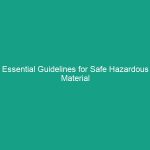Introduction
Good morning team,
Today, we are going to discuss an essential aspect of our daily operations: essential guidelines for safely unloading trailers in construction. This topic is crucial not just for our workflow but also for ensuring each one of us returns home safely at the end of the day. Unloading trailers may seem routine, but it comes with its own set of risks and Hazards that we must address.
By understanding and applying these Safety Guidelines, we can minimize accidents and injuries on the job site. Let’s dive in!
Understanding Essential Guidelines for Safely Unloading Trailers in Construction
The process of unloading trailers is a common task in construction that involves moving heavy materials from trailers onto the job site. It is vital to follow Safety guidelines to prevent accidents that could lead to serious injuries or even fatalities.
Many employees may think that unloading is straightforward and doesn’t require special attention. However, this misconception can lead to overlooking Safety Measures that are critical for our well-being. Always remember, safety is not just about following rules; it’s about protecting ourselves and our co-workers.
Key Hazards, Risks, and Safety Considerations
When unloading trailers, several hazards can arise, including:
- Falling Objects: Materials that are not secured can fall and cause injuries.
- Slips, Trips, and Falls: Uneven surfaces or cluttered areas can lead to accidents.
- Equipment Failure: Malfunctioning unloading equipment can pose significant risks.
- Improper Manual Handling: Lifting heavy items without correct techniques can lead to musculoskeletal injuries.
Ignoring these hazards can have serious consequences, such as injuries that result in time off work or even permanent disability. It is our responsibility to be aware of these risks and take proactive measures to mitigate them.
Best Practices, Procedures, & Actionable Advice
Here are some Best Practices to follow when unloading trailers:
- Conduct a Pre-Task Assessment: Before unloading begins, always assess the work area for hazards. Ensure that the ground is stable and clear of debris.
- Use Proper Personal Protective Equipment (PPE): Wear appropriate PPE such as hard hats, steel-toed boots, gloves, and high-visibility vests.
- Check Equipment: Inspect unloading equipment, such as forklifts or pallet jacks, for proper functioning before use.
- Secure Loads: Ensure that all loads are properly secured and balanced before attempting to unload.
- Use Correct Lifting Techniques: When lifting manually, bend your knees, keep your back straight, and lift with your legs.
- Communicate: Use clear signals and communication with team members during the unloading process to ensure everyone is aware of movements and potential hazards.
For example, a construction site in our area experienced an injury when a worker failed to secure a load properly, resulting in materials falling and injuring another worker. This incident could have been avoided by following the guidelines mentioned above.
Regulations, Standards, and Compliance
It is essential to be aware of the Regulations and Standards that govern unloading Procedures. Compliance with OSHA (Occupational Safety and Health Administration) regulations is mandatory. These regulations outline safety practices that must be adhered to in order to ensure a safe working Environment.
For example, osha has specific guidelines on the safe handling of materials, which includes using appropriate equipment and following established procedures. Understanding these regulations not only protects you but also helps the company avoid penalties and ensures we continue to operate safely.
Employee Engagement & Discussion
Now that we’ve covered the essential guidelines for safely unloading trailers, I’d like to open the floor to discussion. Here are a couple of questions to think about:
- What safety challenges have you encountered related to unloading trailers?
- Are there any additional Safety Measures you believe should be implemented on our site?
Feel free to share your experiences or concerns. Remember, your input is invaluable in creating a safer work environment for everyone.
Conclusion & Key Takeaways
In conclusion, safely unloading trailers in construction is a critical task that requires our full attention and adherence to safety guidelines. By following the Best Practices and being aware of the hazards, we can significantly reduce the risk of accidents.
Let’s commit to prioritizing safety in our unloading procedures. Remember, your safety—and the safety of your colleagues—depends on it. Thank you for your attention and your dedication to maintaining a safe workplace. Stay safe out there!


